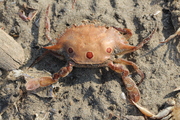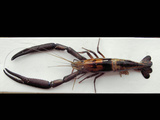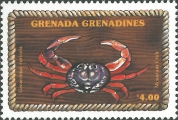Introduction
Decapod crustaceans are familiar to anybody who has ever visited the seashore as a kid or adult, with crabs and shrimps being abundant in rock pools and on beaches. They are however, much more widespread than seashores, and a variety of species live in the deepest ocean trenches, on deep-sea vents, on coral reefs, and in freshwater environments, such as lakes, rivers and in underground caves. They have also colonised land, with some species of living far inland and even up trees in tropical rain forests.
Decapods range in size from barely a cm in length, such as the freshwater shrimp Caridella minuta from Lake Tanganyika and the tiny Asian freshwater crabs of the family Hymenosomatidae to the Giant Japanese Spider Crab, Macrocheira kaempferi with a leg span of nearly 4 metres. Other notable giants are the largest terrestrial arthropod, the Coconut Robber, Birgus latro and the largest freshwater invertebrate, the Giant Tasmanian Crayfish, Astacopsis gouldi.
The order Decapoda is species rich and currently comprises 17,796 species recent species which are divided amongst the major groups as follows:
- Suborder Dendrobranchiata (532)
- Suborder Pleocyamata
(17,264)
- Infraorder Stenopodidea (102)
- Infraorder Procarididea (6)
- Infarorder Caridea (3,944)
- Infraorder Astacidea (792)
- Infraorder Glypheidea (5)
- Infraorder Axiidea (605)
- Infraorder Gebiidea (252)
- Infraorder Achelata (153)
- Infraorder Polychelida (38)
- Infraorder Anomura (3,449)
- Infraorder Brachyura (7,918)
Content and structure of the database
DecaNet aims to be an authoritative listing of all currently accepted species and genera of decapods, both recent and fossil. For all entries, information is provided on the original name spellings, any synonyms and a link to the relevant literature. Additionally, for a growing number of taxa, information is provided on their habitat (and a wider range of traits if applicable) and their distribution.
The higher level classification of DecaNet largely follows the classification, outlined in De Grave et al. (2009), with updates as needed. Much of the information is based on earlier printed nomenclators, such as Ng et al. (2008) for Brachyura, Baba et al. (2008) for squat lobsters and their relatives, Chan (2010) for lobsters, Boyko & McLaughlin (2010) for Hippoidae, McLaughlin et al. (2010a, b) for Paguroidea and Aeglidae, Osawa & McLaughlin (2010) for Porcellanidae, De Grave & Fransen (2011) for the shrimp and Crandall & De Grave (2017) for Astacidea. Of course, changes are continuously published upon and incorporated.
Editorial Team
Co-ordinating Editor
Editorial Board
- Ahyong, Shane: Decapoda, Lithodoidea, Polychelida
- Boyko, Christopher B.: Decapoda, Hippoidea
- Chan, Tin-Yam: Achelata, Astacidea, Glypheidea, Polychelida
- Crandall, Keith A.: Aegloidea, Astacoidea, Decapoda, Nephropoidea
- Davie, Peter: Brachyura
- de Mazancourt, Valentin: Caridina, Decapoda
- Fransen, Charles: Caridea, Decapoda, Dendrobranchiata, Polychelida, Stenopodidea
- Hyžný, Matús: Callianassidae, Ctenochelidae
- Lemaitre, Rafael: Paguroidea
- Macpherson, Enrique: Chirostyloidea, Decapoda, Galatheidae, Munididae, Munidopsidae
- Ng, Peter: Brachyura, Decapoda
- Osawa, Masayuki: Porcellanidae
- Poore, Gary C.B.: Axiidea, Decapoda, Gebiidea
- Santos, Sandro: Aeglidae
- Schweitzer, Carrie: Decapoda (Fossil Decapoda)
- van der Meij, Sancia E.T.: Cryptochiroidea, Decapoda
Feedback
The editors welcome input from visitors to this website who detect errors or omissions. We strive to maintain the website as both a comprehensive and an up-to-date resource and aim to update the database regularly and frequently.
The data in DecaNet are edited and updated by volunteer experts, assisted by the database management team at VLIZ.
Authors are encouraged to send copies of publications to the respective editor or coordinating editor with details of new or revised nomenclature.
References
- Baba, K., Macpherson, E., Poore, G., Ahyong, S., Bermudez, A., Cabezas, P., Lin, C.-W., Nizinski, M., Rodrigues, C. & Schnabel, K. (2008). Catalogue of squat lobsters of the world (Crustacea: Decapoda: Anomura - families Chirostylidae, Galatheidae and Kiwaidae). Zootaxa. 1905, 220 pp.
- Boyko, C. B.; McLaughlin, P. A. (2010). Annotated checklist of anomuran decapod crustaceans of the world (exclusive of the Kiwaoidea and families Chirostylidae and Galatheidae of the Galatheoidea) Part IV – Hippoidea. The Raffles Bulletin of Zoology. Supplement 23: 139-151.
- Chan, T.-Y. (2010). Annotated Checklist of the World\'s Marine Lobsters (Crustacea: Decapoda: Astacidea, Glypheidea, Achelata, Polychelida). Raffles Bulletin of Zoology. Suppl. 23: 153–181.
- Crandall, K.A.; De Grave, S. (2017). An updated classification of the freshwater crayfishes (Decapoda: Astacidea) of the world, with a complete species list. Journal of Crustacean Biology. 37: 615-653.
- De Grave, S., N.D. Pentcheff, S.T. Ahyong, T.-Y. Chan, K.A. Crandall, P.C. Dworschak, D.L. Felder, R.M. Feldmann, C.H.J.M. Fransen, L.Y.D. Goulding, R. Lemaitre, M.E.Y. Low, J.W. Martin, P.K.L. Ng, C.E. Schweitzer, S.H. Tan & R. Wetzer. (2009). A classification of living and fossil genera of decapod crustaceans. Raffles Bulletin of Zoology Suppl. 21: 1-109.
- De Grave, S.; Fransen, C.H.J.M. (2011). Carideorum catalogus: the recent species of the dendrobranchiate, stenopodidean, procarididean and caridean shrimps (Crustacea: Decapoda). Zoologische Mededelingen, Leiden. 85(9): 195-589.
- McLaughlin, P. A., Komai, T., Lemaitre, R. & Rahayu, D.L. (2010). Annotated checklist of anomuran decapod crustaceans of the world (exclusive of the Kiwaoidea and families Chirostylidae and Galatheidae of the Galatheoidea. Part I — Lithodoidea, Lomisoidea and Paguroidea. Raffles Bulletin of Zoology. Supplement 23: 5–107.
- McLaughlin, P. A., R. Lemaitre, and K. A. Crandall. (2010). Annotated checklist of anomuran decapod crustaceans of the world (exclusive of the Kiwaoidea and families Chirostylidae and Galatheidae of the Galatheoidea) Part III - Aegloidea. The Raffles Bulletin of Zoology. Supplement No. 23:131-137.
- Ng, P.K.L.; Guinot, D.; Davie, P.J.F. (2008). Systema Brachyurorum: Part I. An annotated checklist of the extant Brachyuran crabs of the world. The Raffles Bulletin of Zoology. 17: 1-286.
- Osawa, M.; McLaughlin, P. A. (2010). Annotated checklist of anomuran decapod crustaceans of the world (exclusive of the Kiwaoidea and families Chirostylidae and Galatheidae of the Galatheoidea. Part II – Porcellanidae. The Raffles Bulletin of Zoology. Suppl. 23: 109-129.
- Poore, G. C. B. & Ahyong, S. T. (2023). Marine decapod Crustacea: a guide to the families and genera of the world. CSIRO Publishing, Collingwood. xii + 916 pp.
Citation
Usage of data from the DecaNet in scientific publications should be acknowledged by citing as follows:- DecaNet eds. (2025). DecaNet. Accessed at https://www.decanet.info on 2025-12-19. doi:10.14284/600
Individual pages are individually authored and dated. These can be cited separately: the proper citation is provided at the bottom of each page.



